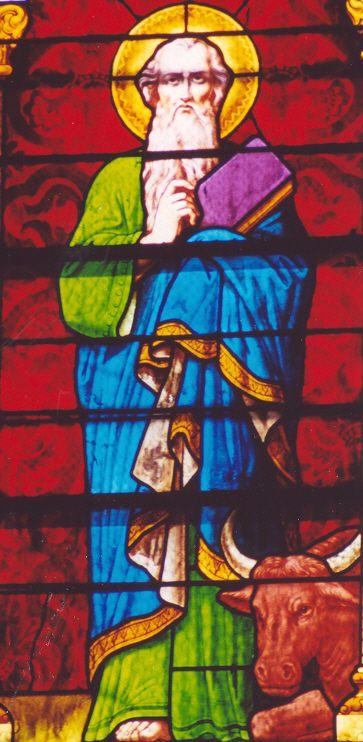
Luke 9:28b-36
Transfiguration Transparency by Rev. Jerome A
Magat
Reprinted with permission of "The Arlington Catholic
Herald"
Home Page
To Sunday Gospel Reflections Index
Luke writes to explain that
Christ came to save everyone.

Jesus took Peter, John, and James and went up the mountain to pray. While he was praying his face changed in appearance and his clothing became dazzling white. And behold, two men were conversing with him, Moses and Elijah, who appeared in glory and spoke of his exodus that he was going to accomplish in Jerusalem. Peter and his companions had been overcome by sleep, but becoming fully awake, they saw his glory and the two men standing with him. As they were about to part from him, Peter said to Jesus, "Master, it is good that we are here; let us make three tents, one for you, one for Moses, and one for Elijah." But he did not know what he was saying. While he was still speaking, a cloud came and cast a shadow over them, and they became frightened when they entered the cloud. Then from the cloud came a voice that said, "This is my chosen Son; listen to him," After the voice had spoken, Jesus was found alone. They fell silent and did not at that time tell anyone what they had seen.
The subject of the fourth luminous mystery of the rosary is one of the most dramatic scenes in all of Scripture. It places Jesus between Moses (representing the Law) and Elijah (representing the Prophets) as the Lord of all history and the fulfillment of "God's promise of a savior. This moment made such an impression on the disciples of the Lord that it is one of the only stories common to all three of the synoptic Gospels.
In St. Luke's version of this event, there is a detail contained in the story, unique to his account: Jesus was transfigured while he was praying. This seemingly minor detail presents some insights into the power of prayer and the relationship between the Transfiguration and the sacrament of Penance.
Just as Jesus was transfigured while He was praying, we are called in a similar manner, to be transformed into saints. Throughout the ages, many saints and theologians have offered different definitions for prayer, but in its simplest terms, prayer is, "the elevation of the mind and heart to God in praise of his glory; a petition made to God for some desired good, or in thanksgiving for a good received, or in intercession for others before God" (CCC Nos. 2559-2565). As the soul is drawn in closer union with God, it is steadily transformed by grace and becomes a more perfect image of God Himself, sharing in the Trinity's inner life. Not only does prayer have the power to secure favors - more importantly, it has the power to transform our will and desires into conformity with God and His loving, providential plan. So, no matter if our petitions are "answered" or not, the persons transformed by prayer will have greater insights into God's will for them, especially if that plan includes a participation in the Passion through suffering.
Not only does the Transfiguration remind us of the transforming power of prayer - it also invites us to consider the transforming power of the sacrament of Penance. When Jesus was transfigured on Mt. Tabor before Sts. Peter, James and John, these three apostles caught a glimpse of Christ's divine glory. In a sense, Jesus uncovered for them an insight into His divine nature. They were able to see Jesus in a very unique and highly privileged manner. It was as if they could see a part of Jesus beyond what mere human sight could discern.
In a similar fashion, this is what can happen for a contrite penitent in the sacrament of Penance. When one approaches our Lord's tribunal of mercy in making a good confession, all of the masks and appearances that we assume in life can be taken off. We lay bare our souls before Jesus' mercy, who sees us as we truly are. No longer must we "put on airs" or "present ourselves" in order to cast a certain image that we would like others to have of us. In effect, we reveal our true self. We allow the grace of Christ's mercy to take our frail humanity and allow it to be purified, strengthened and transformed, so that we become as transparent to Him as He was transparent to the three apostles. The challenge for us after confession is to integrate that true self known to Jesus with the perception that we want others to have of us. The integration of Christ's two natures, held in perfect balance, calls us to become whole and integrated persons.
In the season of lent, we do well to pray for the grace of prayer to transform us, so that we can become as transparent as the Transfigured One through the sacrament of penance.
Please consider a tax deductible gift to support this web site.
Home Page
Top
To
Sunday Gospel Reflections Index